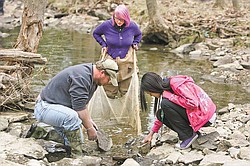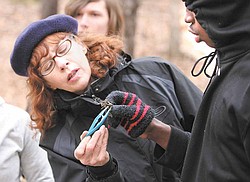Students spend time testing water quality and analyzing insects
The Vindicator (Youngstown)
Kassidy Vath, center, works with Sean McGuire, of Mahoning County Soil and Water, and Theresanne Garcia, as they search for organisms in the Ax Factory Creek Wednesday. Both girls are in eighth grade at Volney Rogers Middle School.
The Vindicator (Youngstown)
Roosevelt Cooper, right, holds a crayfish, while Holly Burnett-Hanley, coordinator of Mahoning River Education Project at Youngstown State University, shows a broken appendage on the creature. Roosevelt was one of many seventh-and eighth-graders in honors science at Volney Rogers Middle School who spent part of the school day Wednesday testing the water quality and analyzing insect life in the stream.
By Denise Dick
YOUNGSTOWN
Students at Volney Rogers Middle School donned waders and rubber gloves to test the water quality in a stream that flows behind the school.
That stream is Ax Factory Run, said Holly Burnett-Hanley, coordinator of Mahoning River Education Project at Youngstown State University.
Seventh- and eighth-graders in honors science at the school spent part of the school day Wednesday testing the water quality and analyzing insect life in the stream.
Eighth-grader Tyrell Johnson, 13, trudged down to the stream, a test tube in one hand and phosphate tablets in the other.
“We’re trying to see if they dissolve in the water to test the chemistry of the water,” he said.
The program is made possible through a federal Learn and Serve America kindergarten-through-12th-grade grant awarded to Earth Force, a nonprofit group that focuses on community problem solving and water. General Motors is a partner in the project.
GM volunteers, YSU’s Center for Urban and Regional Studies, the city schools and the Mahoning County Soil and Water Conservation District are partners in the program.
Eighth graders Kassidy Vath and Theresanne Garcia, both 14, and Taryn Briggs, 13, dug through debris collected from the water looking for bugs and other life.
“We found a crayfish, a snail and a sewer worm,” Kassidy said.
The critters brought out Taryn’s soft side.
“We should nurse that crayfish back to health,” she said. “It’s missing a claw. It’s sad.”
Kathi Vrable Bryan, director of the soil and water conservation district, told the students to look for ripples in the water when scooping up debris. That indicates the presence of oxygen, meaning it’s a good place to look for bugs and other creatures.
Test results show that the water tested in the “fair” range in quality, Bryan said.
“The water quality where we tested was not so great,” she said.
Teacher Nora McDeavitt said the program allows students to enjoy being outside while they’re learning.
“They’re amazed by how much they know,” she said.
 43
43


